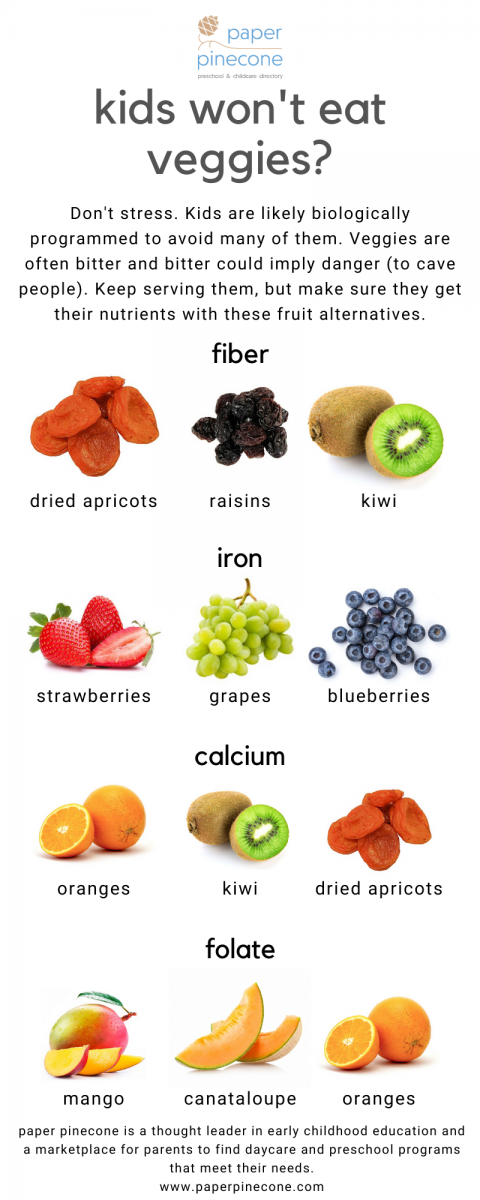Why Kids Hate Vegetables & 17 Tips to Help Kids Love Veggies

Published Date: 08/19/20
If your child loves vegetables, count yourself as lucky! While buddha bowls filled with sweet potatoes and roasted chickpeas seem to be filling up Instagram, many parents are still trying to figure out how to get their kids to eat even the smallest bite of a vegetable - any vegetable. Why do so many adults love a delicious array of colorful veggies while children push their plates away refusing to let one cross their lips?
It turns out there are scientific reasons why children generally don’t like vegetables. But there is hope and we’ll give you tips to encourage your little sprout to eat veggies as quickly as they eat mac and cheese.
So why do kids hate vegetables?
There are two scientific reasons your child may hate veggies.
1. Children are biologically programmed to avoid vegetables
First, we have to go back, way back in time. Our ancestors didn’t have grocery stores where they could shop for safe foods. They had to go out and gather it themselves and they had to rely on their sense of smell and taste to guess if a food was safe. Sweeter plants tended to be safe while bitter tasting plants often signaled that they were toxic or poisonous.
Children are still learning which foods are safe and biology tells them to prefer sweeter flavors (like breastmilk) while also having a higher aversion to bitter foods.
In nature, animals take small tastes of new foods several times to make sure they don’t feel sick before they trust that they can really dig in. Children are no different. It can take up to ten exposures before kids will even try a new food so don’t give up if they don’t touch them the first couple of times.
NEED CHILDCARE? CLICK HERE TO SEARCH THE BEST DAYCARES & PRESCHOOLS
2. Children pick up on bitter flavors more than adults
Babies are born with about 9,000 taste buds and they’re great at regenerating (that’s why you recover in just a few days from a burnt tongue). As you age, taste buds don’t regenerate as well and your sense of taste dulls. Some people are also born with a gene (TAS2R38) that makes them more sensitive to bitter flavor while others are supertasters and have a heightened sense of every taste (salty, sweet, bitter, sour, and umami).
So how can you encourage your children to eat their veggies?
Hiding veggies doesn’t help children learn to like them - quite the opposite. It teaches children that veggies taste bad and have to be hidden. Instead, use these 16 tips to help children try, and fall in love with vegetables.
GOING BAREFOOT BENEFITS BRAIN DEVELOPMENT - READ MORE
Hiding veggies doesn’t help children learn to like them - quite the opposite. It teaches children that veggies taste bad and have to be hidden. Instead, use these 17 tips to help children try, and fall in love with vegetables.
17 tips to help children enjoy vegetables
1. Serve veggies prepared in a variety of ways, both raw and cooked. Roasting veggies brings out their sweetness and dips and sauces can help mask bitterness.
2. Model good eating habits. It’s hard to tell your kiddos to eat their veggies when they notice that you don’t eat them either.
3. Make veggies taste great. When possible, skip the canned vegetables and prepare them fresh.
4. Make a veggie side dish the star with these recipes.
5. Take your child shopping, point out the beautiful colors and shapes of different vegetables and let them pick out new ones to try.
6. Serve a plate of colorful veggies like a rainbow with yummy dips your child already likes.
7. Get kids involved with the cooking and they will want to taste their masterpiece. Even very young children can sprinkle on some seasonings or salt and pepper. Plus, cooking together is a great chance to learn through play at home and hone fine motor skills.
8. Start with sweeter vegetables like sweet corn, carrots, peas, and sweet potatoes to show that vegetables are tasty.
9. If you are still breastfeeding, remember that eating a wide variety of flavors and spices changes the taste of breastmilk which encourages an adventurous eater.
10. Once you introduce solids to your baby, be sure to add vegetables like steamed carrots or slices of avocado to make vegetables a familiar food on your child’s plate as they grow up. If you start with fruits, it might make it harder for kids to make the switch to flavors that aren’t as sweet and yummy.
11. Make smoothies. Mixing veggies with fruits in a tasty drink can help sweeten them and open children up to new foods.
12. Talk about where favorite foods come from. Nearly every child loves pizza and ketchup but they don’t necessarily think about the tomatoes in them.
13. Make up silly names for vegetables. Researchers found that children may turn their noses up at broccoli but are more willing to eat tasty trees or X-ray vision carrots.
14. Start a garden. Getting children involved in cultivating and growing foods leads to a willingness to try - and like - vegetables.
15. Blend them into familiar foods - but don’t hide them. If your child loves hummus, try some roasted red pepper hummus. Salad dressing fans can try homemade avocado cilantro lime dressing.
16. Try plant-based versions of your favorite dishes. Sub out veggies and lentils for ground beef in tacos or use lettuce instead of taco shells.
17. Check out SpinMeal Plate. It makes trying new foods a fun game that kids love.
Developing your child’s palate takes time. Remember, repeated exposure is often needed before a child will dig into those new veggie dishes. And, just because you want a child to love something, doesn’t mean they will. Use a positive parenting approach to mealtime and if you’re concerned about your child getting enough of certain vitamins, keep serving veggies, but use these fruit alternatives below in the meantime.
Paper Pinecone is the #1 most trusted childcare directory giving parents access to the best preschools and best daycares near you. Parents always search free and childcare providers always list free. Send inquiries about the best daycares and preschools to [email protected].
- stacey's blog
- Log in or register to post comments








